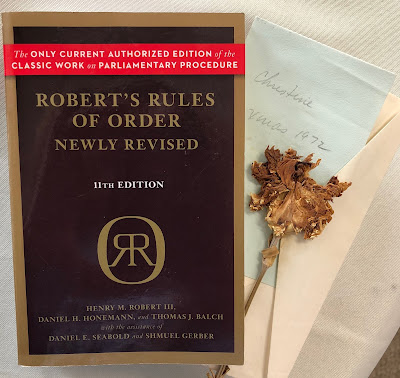When is the last time you put aside an item in a
safe place that held a special meaning to you?
We are all known to tuck away items from time to time as keepsakes and
this week's Find of the Week on the Used Book Floor was just such a
discovery.
Our find
was hidden in a copy of an 11th edition "Robert's Rules of
Order” book published in 2011. This
timeless set of rules for conduct at meetings was first created in 1875 when
Henry Martyn Robert, an engineering officer in the Army, was asked to preside
over a meeting being held in his town.
He quickly realized that he did not know how. After failing miserably and feeling
embarrassed, Robert vowed never to attend or preside over another meeting until
he had researched parliamentary law.
Upon completion of his research, he created the now well-known
"Robert's Rules of Order" guide that has been updated eleven times to
show the progress in parliamentary laws and procedure. You are probably well
acquainted with Robert's Rules and may not have even realized that you have
been following them, or attending meetings where others are. If you are familiar with a call to order,
accepting minutes of a previous meeting or making a motion, you have been
introduced to Robert's Rules of Order.
Does
this discovery make you wonder where your keepsakes are that you once put in a
"safe place" and how long they have been there? Something tells us that the owner of this
special item never thought it would end up on the shelves of a used book floor
in the Lakes Region of New Hampshire just shy of 50 years later.
“Robert's Rules of Order” can be yours for the price of $4.99 and the 46
year-old find is yours, as well. You can
catch up with our previous finds of the week from the used book floor at
bayswaterbooks.com and on facebook. Better yet, stop by our store in Center
Harbor and check out the used book floor for yourself!





















